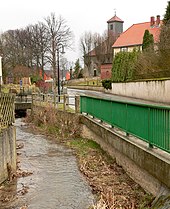St. Stephen's Church (Räbke)
The Sankt-Stephani-Kirche is located in the Lower Saxony municipality of Räbke in the Helmstedt district . It was built in 1801 and is a successor to a church on the same site. Today's parish belongs to the Lelm - Räbke - Warberg parish association within the Evangelical Lutheran regional church in Braunschweig .
description
The square church with hipped roof stands on a small hill near the Schunter . Because of its shape, it is popularly known as a coffee grinder . The church property is fenced in on the north and east side by a wall that existed as early as the 17th century. The stone staircase leading up from the main street to the church entrance was first mentioned in 1736, but is likely to be older.
The church bell dates from 1431. A second bell was built in 1840, but was delivered for army purposes in 1917 during the First World War . In 1920, an iron bell came as a replacement. The old church bell from 1431 was handed in in 1942 during the Second World War . After the war it was found that it was in the nearby Königslutter Cathedral . In 1949 the bell returned to Räbke. The tower clock made by JF Weule from Bockenem dates from 1908.
history
Previous buildings
In the year 835 a small baptistery in Räbke is mentioned in an unprovable, possibly lost document , which was consecrated to Saint Stephen as the patron saint of Halberstadt . The construction of the chapel is said to be based on the fact that the Halberstadt bishop founded bases in the country for Christianization around the year 800 . In the course of time, a village church replaced the chapel . The pastoral office of the church was a fiefdom of the Liebfrauenkirche in Halberstadt until 1568 . There are no other views of the church apart from a picture on a village view towards the end of the 18th century. The structure of the church is described in the church book of 1753. Accordingly, it consisted of a nave in east-west direction with a church tower in the west. The nave was covered with brick and the tower with slate . In 1671 a clock tower is mentioned on the north side of the church tower . While the hour bell was hanging in the roof turret, there were two more bells in the church tower. Inside the nave offered space for 200 people. An organ is first mentioned in 1671. During the Thirty Years' War , the church suffered great damage from the destroyed roof. Towards the end of the 17th century the church building was more dilapidated, so the tower was renewed in 1702 for 400 guilders . After a lightning strike in the church tower in 1790, which had caused considerable damage, the need for a new building was seen. Despite the dilapidation, the church continued to be used for years. The Räbker pastor and the congregation refused to participate in the service in neighboring Warberg because of the long journey. In 1797, on the instructions of a church visitation, the pews were removed so that the church in the less dilapidated area was only used for confession and communion .
Today's church
The plans for the rebuilding of the dilapidated church that arose from 1790 dragged on because no agreement could be reached between the Räbker community and the Duke of Brunswick on the type of construction. The Räbker wanted to keep the tower and only rebuild the nave, while the duke requested a square nave with a central church tower.
In 1799 the foundation stone was laid for the new building of the church, which was carried out according to the ideas of the Duke of Brunswick. The church was consecrated on the first Advent in 1801. The construction costs amounted to 4199 thalers , most of which the duke carried. A smaller part was taken over by the parish and the church. It was advantageous that the stone material near Räbke was broken and a quarry near Warberg could be used for lime burning . The organ was made by the Braunschweig organ builder Hülsmann.
Since 2013 the church has been a station on the Way of St. James in a rival section between Magdeburg and Corvey , whose route leads along the Hellweg . The church has been open to pilgrims every day since 2016 .
literature
- Förderverein Räbker Chronik: (Ed.): The Church of St. Stephen in: Räbke. Ein Dorf am Elmesrand , Helmstedt, 2005, pp. 114–122
- Förderverein Räbker Chronik: (Ed.): The big bell and the clockwork in: Räbke. Ein Dorf am Elmesrand , Helmstedt, 2005, pp. 123–127
- Burkhard Klüppel: 200 years of new construction of the St. Stephen's Church in: Förderverein Räbker Chronik: (Ed.): Räbke. Ein Dorf am Elmesrand , Helmstedt, 2005, pp. 128-133
Web links
- Brief description on braunschweig-touren.de
Individual evidence
- ↑ Pilgrimage map for Ostfalen (pdf)
- ^ Stefan Branahl: Buen Camino. Also in the Diocese in KirchenZeitung for the Diocese of Hildesheim from June 16, 2019 (pdf)
- ↑ Erik Beyen: Village church is always open to pilgrims during the day in Helmstedter Nachrichten of March 27, 2016
Coordinates: 52 ° 11 ′ 39.7 ″ N , 10 ° 52 ′ 43.2 ″ E



